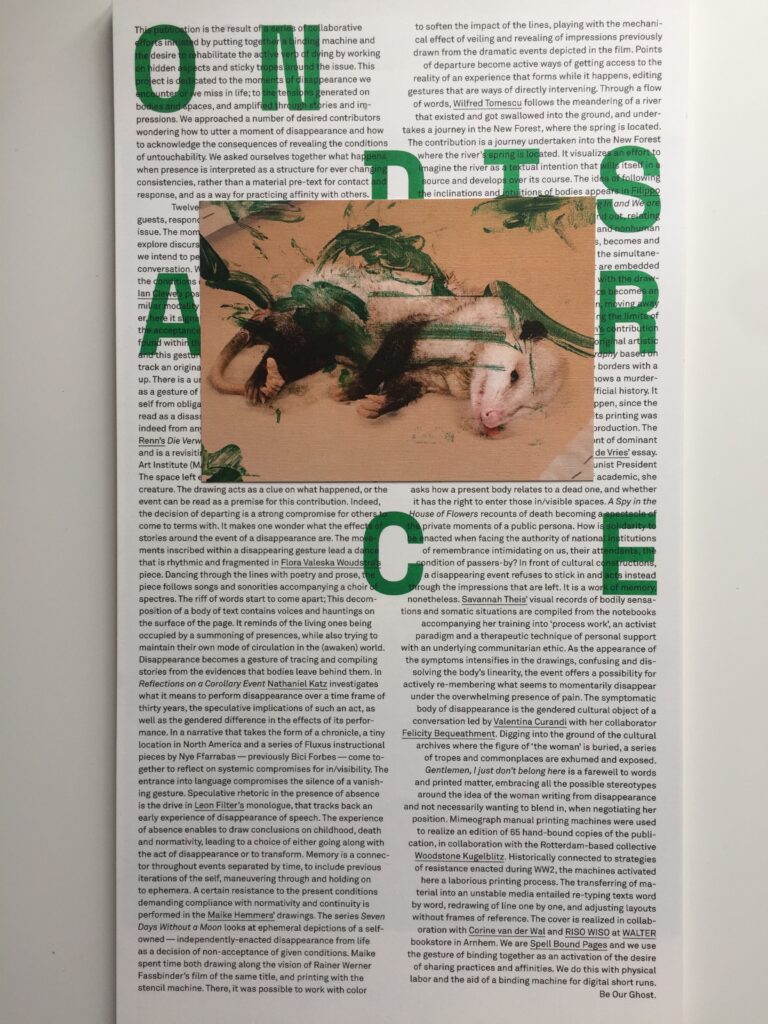On Disappearance, 2018

Publication #1 Fall 2018, Spell Bound Pages editions (Arnhem, NL)
In collaboration with Leon Filter and Flora Woudstra
Contributions from Ian Clewe (D/NL), Maja Renn (POL/CH), Flora Valeska Woudstra (NL), Maike Hemmers (D/NL), Nathaniel Katz (USA/D), Leon Filter (D/NL), Wilfred Tomescu (ROU/GB), Filippo Tocchi (IT/NL), Baha Gorkem Yalim (TUR/NL), Nadia De Vries (NL), Savannah Theis (CH/GB), Valentina Curandi (IT/D). Cover realized with Corine van der Wald (riso wiso, Arnhem)
This publication is part of a collaborative effort to rehabilitate ‘an active tense of dying’ by working on hidden aspects and tropes of death and insisting on making them into a matter of conversation.
We approached several cultural practitioners sharing the question on how to utter a moment of disappearance, as well as how to acknowledge the consequences of exposing its untouchability.
We wanted to focus on narratives, imaginaries and visual processes that could transmit phenomenological positions and experiences of proximity, affect and affinity both in the method (and in the relation with the editors) through the topic of disappearance.
The contributions to the publication entail: artistic interventions about socially accepted forms of isolation and escapism from expectations and requirements in art (Clewe, Renn); poetic renditions of human, nonhuman and ahuman disappearance in words-making processes (Woudstra, Tocchi, Tomescu); chronicles and dialogues on the effects of gendered embodiments and the boundaries of disappearance between everyday life and artistic or cultural production (Katz; Curandi with Bequeathment); textual and visual reflections on the role of the academic or the artist in witnessing the public and private spectacle of death (de Vries; Filter; Yalım); drawing processes that challenge acceptance of given conditions by confusing and dissolving the linearity of bodies and underline the intensity of somatic signals and affects (Theis; Hemmers).
We used ongoing conversations with the contributors as a method to produce the publication’s content. This led to consider the presence-in-absence that shaped our relations in the editing process, and as a nuance of disappearance. An overarching question framed and remained open:
What happens when presence is interpreted as a structure for ever-changing consistencies, rather than a material pretext for contact and response, and as a way for practicing affinity with others?
From previously existing works to new proposition for a contribution, the work consisted in translating into the topic and the format of the publication.
Mimeograph manual printing machines were used to realize the publication, in collaboration with the Rotterdam-based collective Woodstone Kugelblitz. These machines, while being historically connected to strategies of resistance enacted during WWII, activated a laborious printing process. The transferring of material into an unstable media entailed re-typing texts word by word, re-drawing lines one by one, and adjusting layouts without frames of reference but the desires of the contributors to be rendered in distance.